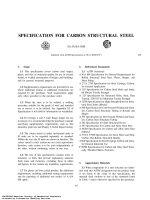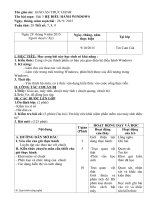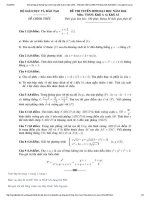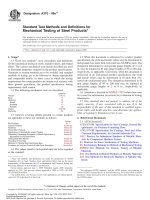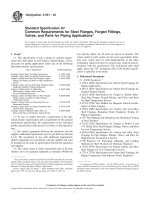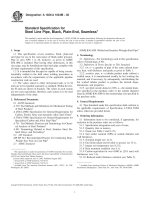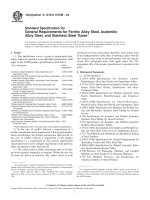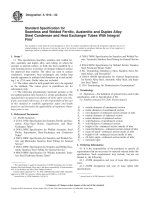Astm a 921 a 921m 93 (2016)
Bạn đang xem bản rút gọn của tài liệu. Xem và tải ngay bản đầy đủ của tài liệu tại đây (77.57 KB, 3 trang )
Designation: A921/A921M − 93 (Reapproved 2016)
Standard Specification for
Steel Bars, Microalloy, Hot-Wrought, Special Quality, for
Subsequent Hot Forging1
This standard is issued under the fixed designation A921/A921M; the number immediately following the designation indicates the year
of original adoption or, in the case of revision, the year of last revision. A number in parentheses indicates the year of last reapproval.
A superscript epsilon (´) indicates an editorial change since the last revision or reapproval.
1. Scope
A576 Specification for Steel Bars, Carbon, Hot-Wrought,
Special Quality
A788/A788M Specification for Steel Forgings, General Requirements
E45 Test Methods for Determining the Inclusion Content of
Steel
1.1 This specification covers hot-wrought, special quality
microalloyed carbon steel bars intended for use as hot forging
stock. The bars shall be hot-wrought, as-wrought, unless
thermal treatment is necessary to ensure cold shearability.
1.2 The bars shall be furnished to chemical composition
only. Chemical composition is based on standard carbon steel
grades modified to include microalloying elements such as
columbium (niobium), vanadium, or molybdenum. Desired
mechanical properties are developed in the subsequent hot
forging and controlled cooling operations.
3. Terminology
3.1 Definitions of Terms Specific to This Standard:
3.1.1 microalloyed steels—microalloyed steels are carbon
steels to which small quantities of certain elements are added
in order to enhance mechanical properties. This enhancement
of mechanical properties results from control of the temperature and cooling rate during the final hot-working process.
1.3 Sections and sizes of bar steel available are covered in
Specification A29/A29M.
1.4 Supplementary Requirements S1 to S6 are provided for
use when additional controls or requirements are desired.
These shall apply only when specified on the purchase order.
4. Ordering Information
4.1 Orders for material supplied to this specification should
include the following, as required, to describe adequately the
desired material:
4.1.1 Quantity (weight or number of bars),
4.1.2 Name of material (hot-rolled microalloyed steel bars),
4.1.3 Dimensions,
4.1.4 ASTM specification number and date of issue,
4.1.5 Grade designation or chemical composition limits (see
8.1 – 8.5),
4.1.6 Type (see 7.1) to designate grain refiner,
4.1.7 Additions to the specification and Supplementary
Requirements, if required, and,
4.1.8 End use.
1.5 The values stated in either inch-pound units or SI units
are to be regarded separately as standard. Within the text and
tables, SI units are shown in brackets. The values stated in each
system are not exact equivalents; therefore, each system must
be used independently of the other. Combining values from the
two systems may result in nonconformance with the specification.
1.6 Unless the order specifies the applicable “M” specification designation, the material shall be furnished to the inchpound units.
2. Referenced Documents
5. General Requirements
2.1 ASTM Standards:2
A29/A29M Specification for General Requirements for Steel
Bars, Carbon and Alloy, Hot-Wrought
5.1 Material furnished under this specification shall conform to the applicable requirements of the current edition of
Specification A29/A29M, unless otherwise provided in this
specification.
1
This specification is under the jurisdiction of ASTM Committee A01 on Steel,
Stainless Steel and Related Alloys and is the direct responsibility of Subcommittee
A01.15 on Bars.
Current edition approved Sept. 1, 2016. Published September 2016. Originally
approved in 1993. Last previous edition approved in 2011 as A921/
A921M - 93(2011). DOI: 10.1520/A0921_A0921M-93R16.
2
For referenced ASTM standards, visit the ASTM website, www.astm.org, or
contact ASTM Customer Service at For Annual Book of ASTM
Standards volume information, refer to the standard’s Document Summary page on
the ASTM website.
6. Materials and Manufacture
6.1 Melting Practice—The steel shall be produced in accordance with the applicable methods for primary and secondary
melting outlined in Specification A788/A788M.
6.2 The steel shall be killed. Supplementary Requirements
S1 through S6 may be invoked upon agreement between
producer and purchaser.
Copyright © ASTM International, 100 Barr Harbor Drive, PO Box C700, West Conshohocken, PA 19428-2959. United States
1
A921/A921M − 93 (2016)
TABLE 1 Typical Chemical Compositions of Microalloyed Carbon Steels
NOTE 1—These compositions are identical to those in Specification A576, with the exception of the addition of vanadium.
Chemical Composition Limits, %
Grade Designation
10V40
10V45
11V37
11V41
15V24
15V41
C
MN
0.37–0.44
0.43–0.50
0.32–0.39
0.37–0.45
0.19–0.25
0.36–0.44
0.60–0.90
0.60–0.90
1.35–1.65
1.35–1.65
1.35–1.65
1.35–1.65
P
0.040
0.040
0.040
0.040
0.040
0.040
max
max
max
max
max
max
S
V
0.050 max
0.050 max
0.08–0.13
0.08–0.13
0.050 max
0.050 max
0.02–0.20
0.02–0.20
0.02–0.20
0.02–0.20
0.02–0.20
0.02–0.20
TABLE 2 Chemical Requirements—(Microalloy Elements)
Chemical Ranges and Limits, %
6.3 The bars shall be special quality.
Element
6.4 The bars shall be hot-wrought, as wrought.
Vanadium
Columbium (Niobium)
Molybdenum
7. Metallurgical Requirements
7.1 Grain Size—The steel shall conform to the fine grain
size requirement of Specification A29/A29M. The grain refining element may be specified according to one of the following
types:
7.1.1 Type A—Aluminum—The total aluminum analysis
shall be 0.020 % or greater, and shall be reported.
7.1.2 Type B—The grain refining element shall be specified
in accordance with 5.1.2.3 of Specification A29/A29M.
Heat Analysis
Product Analysis
0.02–0.20
0.005–0.07
0.01–0.30
0.01–0.21
0.004–0.08
0.31 max
8.4 Titanium may be added for refinement of the austenitic
and the as-forged ferritic grain size, or as a precipitation
strengthener. When titanium is specified, the titanium limits
shall be as agreed upon between producer and purchaser. The
titanium analysis shall be reported.
8.5 Nitrogen may be specified as a supplement to vanadium,
columbium, or titanium. When nitrogen is specified to supplement vanadium, the minimum ratio of vanadium to nitrogen
shall be 4 to 1. The nitrogen content shall not exceed 0.03 %
and shall be reported.
8. Chemical Composition
8.1 Typical examples of chemical compositions are shown
in Table 1. Other compositions may be specified using one of
the following methods:
8.1.1 Base compositions selected from Table 1 of Specification A576, with the addition of microalloying elements as
provided in 8.3 – 8.5, or
8.1.2 Base compositions using the ranges and limits shown
in Specification A576, with the addition of microalloying
elements as provided in 8.3 – 8.5
8.6 Sampling for heat and product analysis shall be in
accordance with the requirements of Specification A29/A29M.
9. Workmanship and Appearance
9.1 The bars shall be free of visible pipe and conditioned as
necessary to remove any injurious surface imperfections.
10. Certification and Test Reports
10.1 When specified by the purchaser, a manufacturer’s
certification that the material was manufactured and tested in
accordance with this specification together with a report of the
heat analysis for the specified elements and for copper,
chromium, nickel, molybdenum, vanadium, and columbium
shall be furnished. When the amount of an element present is
less than 0.02 %, the heat analysis may be reported as <0.02 %,
except for titanium, aluminum, and nitrogen. When specified,
these elements shall be reported to three decimal places.
NOTE 1—For improved machinability, alternative sulfur ranges may be
specified by agreement between the purchaser and the producer. Additional machinability-enhancing elements such as lead, bismuth, selenium,
or tellurium may also be specified by agreement.
8.2 Silicon analysis shall be 0.15/0.35 %. Silicon content up
to 0.80 % maximum may be furnished by agreement between
purchaser and producer.
8.3 Vanadium, columbium (niobium), or molybdenum may
be specified singly or in combination, subject to the limits
shown in Table 2. The elements and ranges specified shall be
by agreement between the purchaser and the producer.
11. Keywords
11.1 carbon steel bars; microalloyed steel; steel bars
2
A921/A921M − 93 (2016)
SUPPLEMENTARY REQUIREMENTS
One or more of the following supplementary requirements shall apply only when specified by the
purchaser.
S1. Restricted Chemical Composition
NOTE 2—In resulfurized steels, much of the sulfur is present as sulfide
inclusions. For this reason, maximum sulfide inclusion level should not be
specified.
S1.1 Restricted heat analysis limits or ranges or restricted
product analysis tolerances on one or more elements may be
specified by the purchaser if the manufacturer agrees to meet
the requested restriction.
S4. Calcium Treatment
S4.1 The steel shall be calcium treated.
S2. Restricted Incidental Elements
S5. Thermal Treatment to Insure Cold Shearability
S2.1 The steel shall not exceed the limits for copper, nickel,
chromium, molybdenum, or other elements as shown on the
purchase order.
S5.1 The bars shall be thermal treated to ensure cold
shearability. The type of treatment shall be as agreed upon
between the purchaser and producer.
S3. Nonmetallic Inclusion Requirement
S3.1 A microscopical examination of longitudinal sections
to determine the nature and frequency of nonmetallic inclusions shall be made as prescribed in Test Methods E45. The
acceptance limits shall be specified by the purchaser.
S6. Cleaning
S6.1 The surface of the bars shall be descaled by pickling or
shotblasting, or other suitable means.
ASTM International takes no position respecting the validity of any patent rights asserted in connection with any item mentioned
in this standard. Users of this standard are expressly advised that determination of the validity of any such patent rights, and the risk
of infringement of such rights, are entirely their own responsibility.
This standard is subject to revision at any time by the responsible technical committee and must be reviewed every five years and
if not revised, either reapproved or withdrawn. Your comments are invited either for revision of this standard or for additional standards
and should be addressed to ASTM International Headquarters. Your comments will receive careful consideration at a meeting of the
responsible technical committee, which you may attend. If you feel that your comments have not received a fair hearing you should
make your views known to the ASTM Committee on Standards, at the address shown below.
This standard is copyrighted by ASTM International, 100 Barr Harbor Drive, PO Box C700, West Conshohocken, PA 19428-2959,
United States. Individual reprints (single or multiple copies) of this standard may be obtained by contacting ASTM at the above
address or at 610-832-9585 (phone), 610-832-9555 (fax), or (e-mail); or through the ASTM website
(www.astm.org). Permission rights to photocopy the standard may also be secured from the Copyright Clearance Center, 222
Rosewood Drive, Danvers, MA 01923, Tel: (978) 646-2600; />
3
